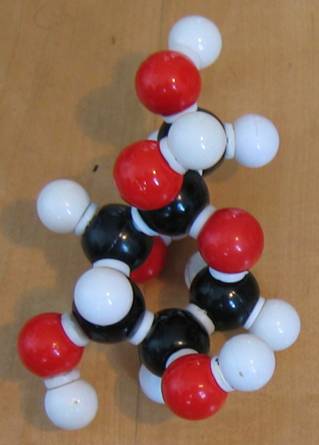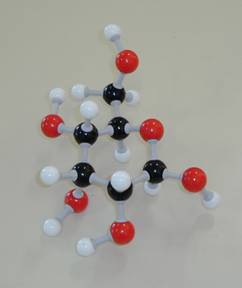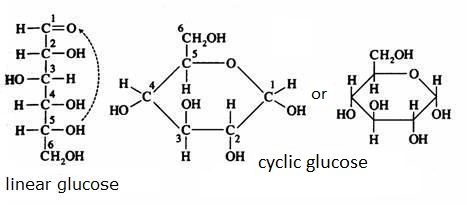Carbohydrates, saccharides
The concept "carbohydrates" as historically made up in natural sciences, but is, in fact, a wrong word.
The saccharides can be considered as C-chains with aldehyde or keton groups, combined with some OH groups.
The suffix to recognize them is ....ose.
They serve as energy rich food.
Mono-, di-, (oligo-) and polysaccharides
Examples:
- glucose and fructose
- sacharose and maltose
- amylose and cellulose in plants, and glicogene in animals
Check the formula C6H12O6 in the images below.


the cyclic structure of glucose
- Please recognize the structure of the aldehyde group
- Please recognize OH groups in the structure
Monosaccharides
They are the monomers of the polysaccharides. There are various types of monosaccharides, depending on:
- the number of C atoms: tetrose, pentose, hexose, heptose...
- the presence of an aldehyde or a keton group: aldose and ketose
- the structure of the whole molecules, linear or open, or: closed or cyclic.
five examples of monosaccharides:
Glucose α and β
Galactose
Fructose
Ribose


Cyclic or linear
Monomers normally have both structures: cyclic and linear. The two are continuously in equilibrium with each other (supposed that they are dissolved in water).
Note that the cyclic structure has lost its specific aldehyde or keton group.
But always the ring of the cyclic structure is closed with an O atom that has a position in between two C atoms.
This phenomena has consequencies for the reactivity of the substances.

Disaccharides
Disaccharides are "dimers": built up of two monomers having a cyclic or a linear structure.
The bonding between these monomers could be called an 'oxygen bridge': you always will note the following bonding: C - O - C
Examples:
Saccharose has two rings: one of glucose and one of fructose. In daily life we speak of sugar.
 |
| maltose |
saccharose |
Maltose also is built up of two monomers (2 x glucose), of which one can have a linear structure and the other only can have a cyclic structure.
polysaccharides
Hundreds or thousands of monomers, in particular of glucose, participate, are connected and form a very long chain: a macromolecule.
In general can be stated that all parts are cyclic.

Examples:
- in plants: amylose or starch, and cellulose
- in human/animal: glycogene
Starch + ion I3-









